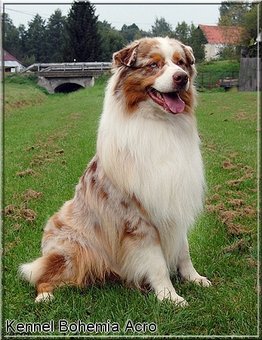
Australian Shepherd
About Australian Shepherds
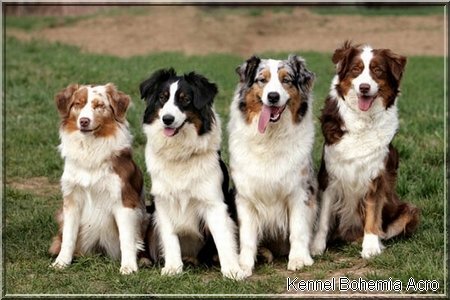
.
There are many theories about the origin of the Aussie (Australian Shepherds). However, it is dead certain that it comes from the USA and not from Australia as indicates the name of the breed. The creation of this breed has been mainly influenced by dogs of Basque sheepherders, who came to America from Australia. The Indians called the Australian Shepherds as Ghost-Eye dogs. Aussie eyes ma y be any shade of black, green, blue, brown, marbled... or they may have two different coloured eyes. The dogs may have any eye colour irrespective of the colour of the coat.
There is also great variety in coat colour of Australian Shepherds, where the black and brown (red) are the base colours. Then, you may or may not complete these base colours with colour dilution (locus B), markings or merle pattern. The result of irregular dilution of black is Blue-merle and of red colour dilution is Red-merle with or without white markings. However, their distribution and number is restricted and defined in FCI standard.
.
Miniaussie - Miniature Australian Shepherd
Besides the standard Australian Shepherds the so-called „Miniaussies" are becoming more and more popular. The Miniature Australian Shepherd was developed directly from the Australian Shepherd. In 1968, the breeder Doris Cordova from California started breeding very small Australian Shepherds. Cordova's Spike was the first dog designated as Miniature Australian Shepherd.
Since 1968 the breeders have been developing Miniaussies by selective breeding and in-breeding methods. According to the standards of the NAMASCUSA club, its height should range approx. from 35 to 45 cm at the withers and should be able to perform all activities as its bigger relative.
The first parent club, which was engaged in registration, development and support of Miniaussies, has been established in 1990 as Miniature Australian Shepherd Club of the USA (MASCUSA). Today, the main breeding organisation is called North American Miniature Australian Shepherd Club of the USA (NAMASCUSA). However, neither the club nor the breed is recognised by FCI.
The breeders of Miniaussies are still struggling for breeding the Aussies of smaller size. The priorities of the breeding programme are maintaining their herding instinct, intelligence and extraordinary good physical condition as well as good reputation as to its health and companionship. Miniaussies have become increasingly popular even in disciplines such as agility, flyball and disc dog. The advantages of these dogs are small size and amazing athletic capabilities. It can be said that the mini Aussie is a smaller and „inside" form of the standard Australian Shepherd, which is suitable for suburban breeders. The Miniaussies can be occupied with herding as well. Nowadays, they are frequently bred in the USA and Europe.
.
Genetics of coat colors in Shepherds
Suitable coat color tests for Australian Shepherds are: Locus A, Locus B, Locus E, Locus D. The tests are performed on samples of blood or buccal swabs.
Locus B causes brown coat color and nose:
In Australian Shepherds is genotype ee causing "pure red" very rare. Genotype bb causing brown coat color in Australian Shepherds is named like red coat color phenotype by breeders or RED FACTOR.
Locus D causes color dilution:
- genotype DD - no dilution
- genotype Dd - carrier of dilution
- genotype dd - diluted color
Locus A causes trikolor (genotype at/at) or bicolor (genotype a/a). Generally, There have been described 4 alleles with the dominance hierarchy as follows: ay >aw> at> a. Alleles ay ,aw, at are designated jointly A-alleles (Agouti) and a-allele (non-agouti). Important for Australian Sheperds are alleles at and a. Allele at causes tricolor coat.
Genotypes of tricolor:
- atat
- ata - bicolor carrier
Genotypes of bicolor:
- aa
Basic coat color of Australian Shepherd can be combinated with merle. Continue to special artical about merle coat color.
Coat color overview is sorted firstly by nose color (brown x black). Later black-nose Sheperds are devided in to group of potencial carriers of pure red and potencial carriers of brown (red).
.
Australian Shepherds with brown nose (caused by bb genotype)
|
Genotype |
Coat color |
Nose color |
Transmission of coat color |
|
EEbb |
brown (red) |
brown |
- |
|
Eebb |
brown (red) |
brown |
pure red (red variants) |
|
eebb |
pure red |
brown |
- |
.
Example of brown tricolor with brown nose:
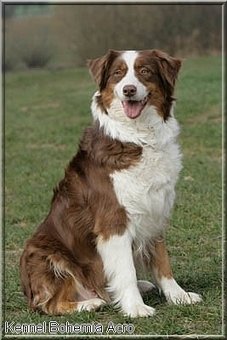
.
Australian Shepherds with black nose (caused by BB or Bb genotypes), potencial carriers of pure red color
|
Genotype |
Coat color |
Nose color |
Transmission of coat color |
|
EEBB |
black |
black |
- |
|
EeBB |
black |
black |
pure red (red variants) |
|
eeBB |
pure red |
black |
.
Australian Shepherds with black nose (caused by BB or Bb genotypes), potencial carriers of brown (red) and pure red color
|
Genotype |
Coat color |
Nose color |
Transmission of coat color |
|
EEBb |
black |
black |
brown (red) (brown variants) |
|
EeBb |
black |
black |
brown (red) (brown variants) pure red (red variants) |
|
eeBb |
pure red |
black |
brown (red) (brown variants) |
.
Examples of Australian Shepherds with black nose:
- tricolor
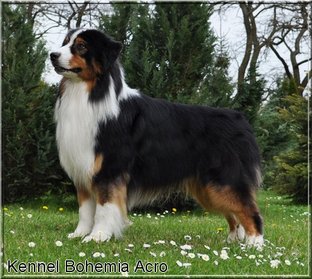
.
- blue merle
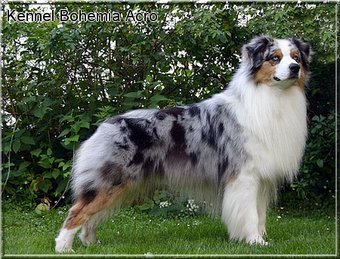
.
- red merle
